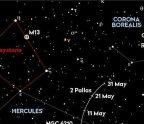OBSERVE MARS AT ITS BEST

At long last Mars’s great opposition is upon us this month, and it’s time to make the most of its closeness to Earth, as well as its brightness and height in the sky. In this feature we’ll help you to maximise your telescope views of the Red Planet, with a guide to the Martian features that will be best to view each week. Two dates to mark on the calendar are when Mars comes closest to Earth, a distance of 62 million km, at 15:19 BST (14:19 UT) on 6 October, and a week later, on 13 October, when it reaches opposition. This year the Red Planet is also notable for reaching an altitude of around 42˚ from the UK and presenting a maximum disc size of 22.6 arcseconds; after 2020, we won’t see Mars’s apparent disc size exceeding 20 arcseconds again until 2033.
You’re reading a preview, subscribe to read more.
Start your free 30 days





